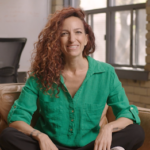Humour me in trying a social experiment. Go and ask a sample of people in your team or organisation this question: Did anyone ever teach you HOW to learn?
The majority of people you ask will say NO, but for the small percentage who might say yes, ask them this follow up question: Did anyone ever teach you about your brain?
My guess is that the answer will be no, just like the tens of thousands of people I’ve asked globally over the course of the last eight years, and it all started with me.
No one ever taught me how to learn
Course changing questions
Over a decade into my career as a learning professional I thought I had a pretty good handle on it all, until those two questions brought me to an abrupt stop, changing the course of everything to come.
If I close my eyes and tap into the memory, I can still see myself sitting on my couch in the living room, tears streaming down my face and, at the same time, frustrated. I couldn’t understand why I was having such a hard time with my studies in neuroscience, and that’s when it came to me.
No one ever taught me how to learn, and up until that point I certainly wasn’t taking into consideration the role of my brain, in neither my professional or personal life.
Should we be embarrassed?
Maybe a little at this point. You’d think as learning professionals, who are literally in the business of helping to change someone else’s brain through the learning designs, training sessions and the strategies we provide, that we’d know even at a foundational level, a little about the science of learning and the thing doing it all. And yet, sadly we don’t. But why?
It wasn’t my fault though and it isn’t yours either. Let’s talk about a little habit and behaviour.
Everything I thought was learning came from years of being in school, which taught us how to rote memorise, highlight the odd paragraph, take endless pages of notes and sit mindlessly in lectures and classes for hours on end.
We cultivated very strong habits, behaviours and beliefs around what learning is and how to go about it. Any one of you reading this now, who has tried to change any one of those things as an adult, knows how challenging it can be.
It’s not that you’re doing it wrong, but you can be doing it better
Change is hard
Those neural networks are strong and the brain doesn’t welcome change with a warm hug and a plate of cookies. It makes us work for it. After all, even though we can’t see it, we are literally changing the physical aspects of our brain, a little something called neuroplasticity.
And guess where we brought those habits and behaviours? You guessed it, into our professional lives and through the doors of the organisations we work for. It’s not that you’re doing it wrong, but you can be doing it better.
It would stand to reason that if we, as learning professionals, never really learned how to learn ourselves, then the things that we are creating and designing are probably not hitting the mark as well as they could be. Makes sense right?
As I went further into my studies about the brain and started to see the flaws in the ways I designed, facilitated and taught, I kept hearing myself say over and over again: “How did I not know this?”. Very simply, again, no one ever taught me.
Room for improvement
In order to improve everything I was doing as a learning professional though, I was willing to wave my white flag and come to the conclusion that I wasn’t doing it wrong, but I certainly could be doing it better.
I’m now able to very clearly see the impacts of poor learning design and poor learning habits and they can be both profound and far-reaching. From exceptional amounts of money being wasted, talented humans leaving organisations out of frustration, and leaving those left behind to pick up the slack and take on unnecessary stress, to the trend we’ve seen in the years following the pandemic. Entire learning and development teams being made redundant with one email.
What are we going to do about this and where do we start?
First, it’s time as an industry of learning professionals to wave the white flag of not knowing, feel how empowering it can be to admit that, and then use that to spark a flame of motivation to learn. Time to upskill the upskillers if you will.
I know that artificial intelligence (AI) is all the rage right now, but it barely outperforms the human brain on several levels. So start with some of the basics: how do we learn? How does the brain do all the processing and the creation of memories?
After all, if you don’t know this, then it won’t matter how fast AI can spit out a learning program. If you can’t vet that for actual human learning, performance and transfer, then what’s the use?
Let curiosity guide your journey
Chase the curiosity of your brain
Then, just as you would for your internal clients, find the SMEs (subject matter experts). Find people like me, who have done all the heavy lifting so you don’t have to go through the madness of translating complex science into easily digestible and practical use.
Do that and you’ve already won half the battle. You may already have some learning scientists or behavioural scientists in your organisation as we’re getting integrated into businesses more and more.
A word of caution though, for externals, please verify the credentials and the experience of those people, as there are several out there who are happy to misrepresent the science and perpetuate a wider spread of myth and ineffective learning.
Lastly, let curiosity guide your journey. Just like Alice chased the rabbit through Wonderland, you can chase the curiosity of your brain and open a whole new world of human possibility.
I’ve been doing it for nearly a decade now and it never ceases to amaze me how much more I can be, feel and do with every piece of the brain puzzle I get.





